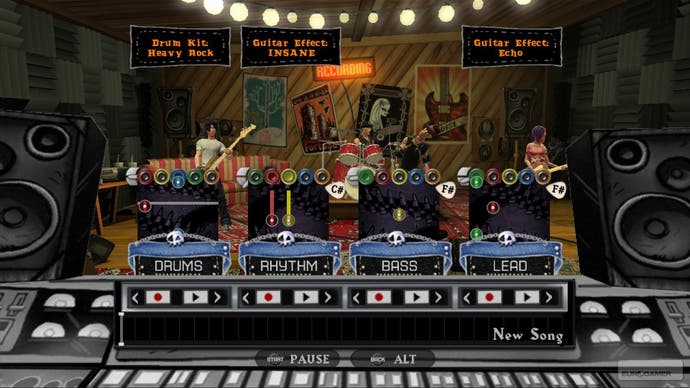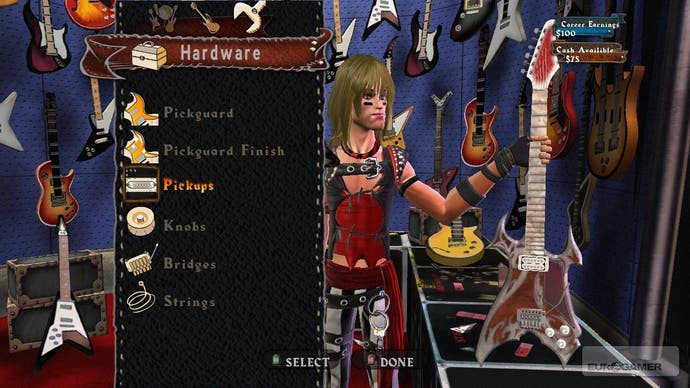Guitar Hero World Tour
Chord progression.
So, you've got your band kit, and you've found some suitably rock'n'roll additional members: now it's time to create your colourful virtual personas. No wait, come back! World Tour is a multi-featured product and the character and instrument creation mode is one many gamers will never use; but it underlines how comprehensive Neversoft wants World Tour to be from the very first iteration.
Create-A-Rocker uses tech purloined from the Tony Hawk series. "We wanted to try and compete with the Tiger Woods out there on facial deformation," says Bright. Thus, for instance, you can change the age of a face from fresh-faced teen to microwave-shrivelled Keith Richards; change the depth, position, bridge angle or width of the nose; individually tweak the thickness of each lip; plaster on detailed make-up and body art, layering tattoos which can incorporate text; and play fancy dress with outfits covering a menagerie of unfortunate fashions.
This tweakers' paradise extends to instruments, too: once you've picked out your axe of choice you can change everything from the fretboard and head stock, to pickups, knobs and bridge. With drums, a dizzying array of skins, shells and sticks await the irredeemable percussion bore; and spotlight-hogging vocalists can indulge their narcissistic sense of entitlement by pointlessly mulling over mic and stand models.
Again, you may shudder at the thought of such fastidious absurdity, but it doesn't change the core game experience, and you don't have to go anywhere near it. The point is, it's there if you want it.
One area where countless hours of incessant poking, pressing, prodding and perfecting will make a huge difference is in the Music Studio - unquestionably Guitar Hero World Tour's star attraction, and quite possibly the most exciting thing to happen to the genre since, well, the original Guitar Hero.

The premise is intoxicatingly simple: in Rock Band you pretend to be the band and play the music; in World Tour you are the band and you're making the music. In essence, the game features a comprehensive multi-track recording facility that lets you record music note by note, instrument by instrument, play it back in game and share it online.
This feature - or "game within a game" as Neversoft has it - owes its existence to the ultra-hardcore Guitar Hero community which has flooded YouTube with videos of axe-wielding braggadocio, and at its most extreme, amazing feats of hacking. That's how Travis, the chap heading up development on the Music Studio feature, got his job: he hacked into Guitar Hero and got it working on a PC. "It's jail or a dev job for pennies, son." Something like that, anyway.
It's left to straight-shooting Neversoft president Joel Jewett to hit the nail on the head: "It's a f***ing s***load of work to hack the game and make a video, note-track it yourself and get it on YouTube. If there's that many people doing that, and we give them tools that make it easy to do it at home in the living room... s*** man, it could be cool." As if to emphasise the point, Jewitt's huge, fluffy white dog has curled up and gone to sleep on our feet.
"We've embraced the whole custom community and we're giving fans what they want," adds Bright. "It's a full recording studio and an online repository; a library for people to post their songs."
So, you're probably wondering how it all works, right? The studio offers a four-track recording facility for guitar, bass, drums and a keyboard-like melody line. Perhaps the only obvious disappointment is an inability to record vocals - it's restricted to karaoke over-the-topping only. "Adding vocals to a four-to-five minute song would make it 10-20Mb, so it would bloat the file-size incredibly large," reasons Bright. And, more to the point, "it could be full of bad words that would piss off Microsoft and Sony". Best not let your boss near it then, Brian.

Let's start with the guitar. Using the buttons, strum bar and fiddling with the settings you can basically play any note you like. A scales menu lets you switch between blues, pentatonic and so on, or create a custom scale. On the rhythm side you can choose chords based on harmonics (e.g. a Maj7), or by style (distorted, acoustic, power etc.) A palm-mute can be effected by hitting the back button with, yep, your palm.
You have a three-octave range to play with, choosing either the upper of lower two in advance and switching between them by tilting the guitar.
Stick-men and women, meanwhile, can pick from a range of kits, including classic rock, modern indie, South American percussion and congos. Music Studio is also where the velocity-sensitive drum pads come into their own. The velocity range allows for up to four separate samples to be assigned to each pad: which one plays depends on how hard you hit it. Touch sensitivity also gives a "really sweet sound" in solos, apparently.
If your puny mind is struggling to comprehend such nuances, or you're just bone-idle, you can lay down a live recording. But if you take this sort of thing seriously, Advanced Recorder gives you a midi sequencer in which you can set tempo, record notes step by step, copy and paste sections, and make use of a nudge tool for fine-tuning. You can even lay down specific markers to time your on-stage light show.


